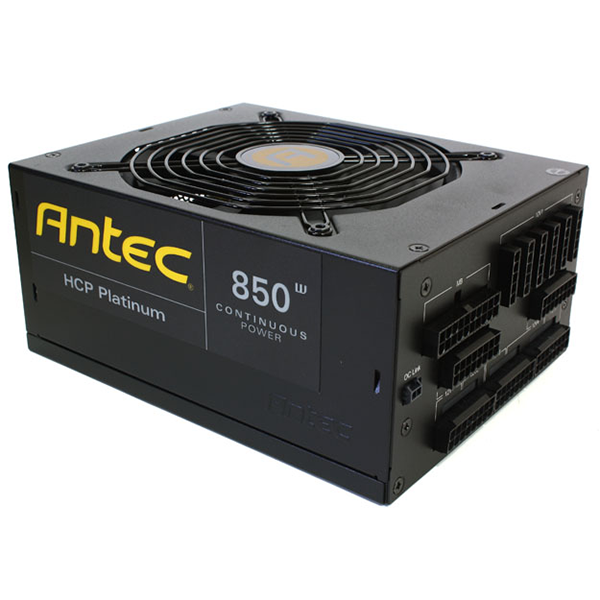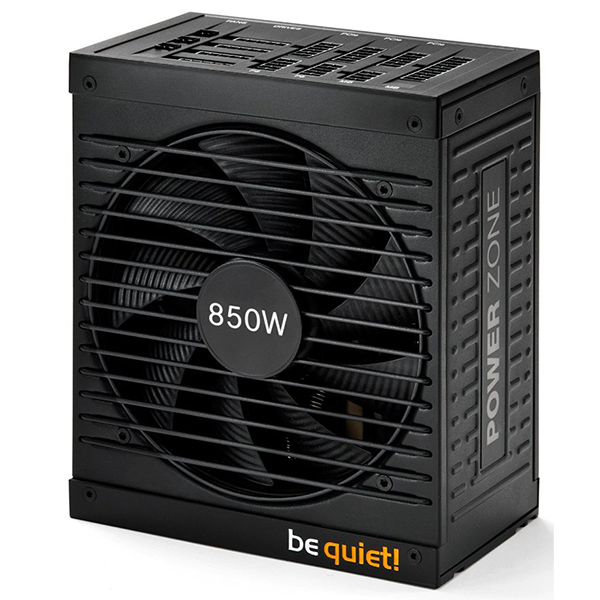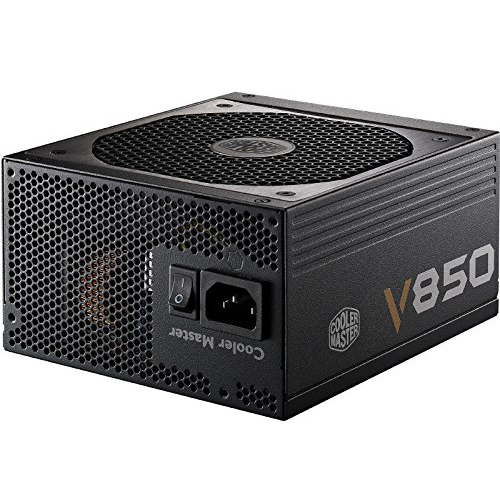be quiet! Dark Power Pro 11 850W Power Supply Review
Why you can trust Tom's Hardware
Load Regulation, Hold-Up Time And Inrush Current
To learn more about our PSU tests and methodology, please check out How We Test Power Supply Units.
Primary Rails And 5VSB Load Regulation
Load Regulation testing is detailed here.
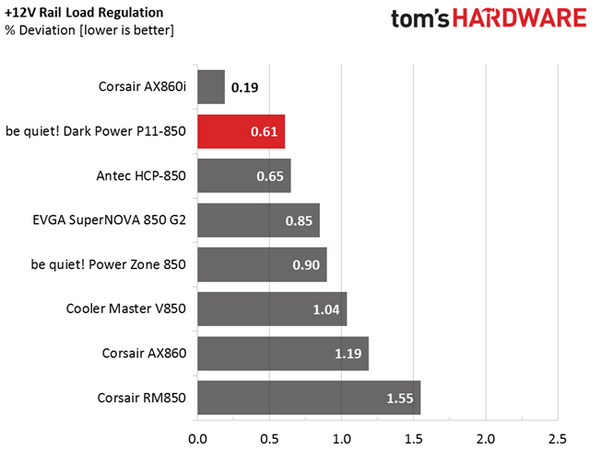
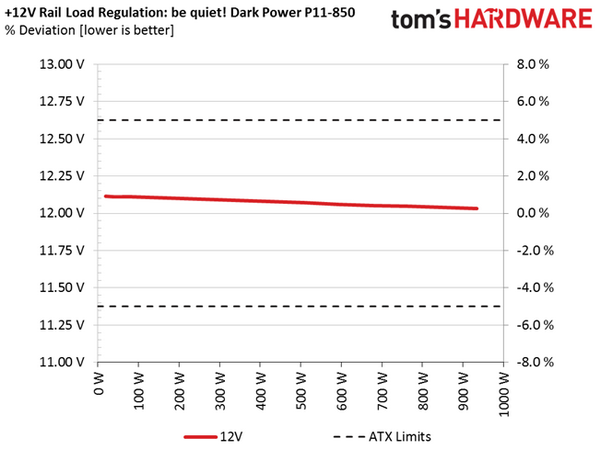
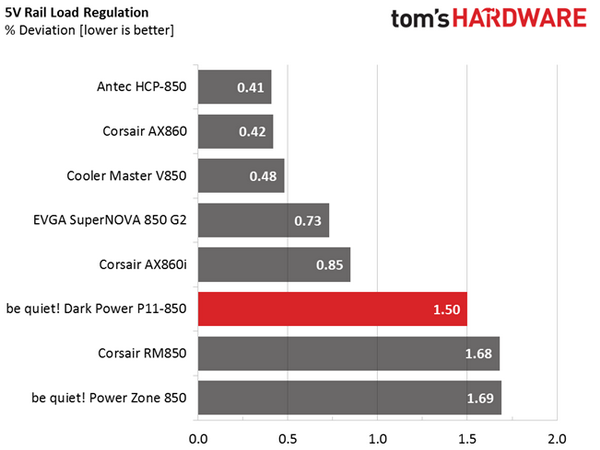

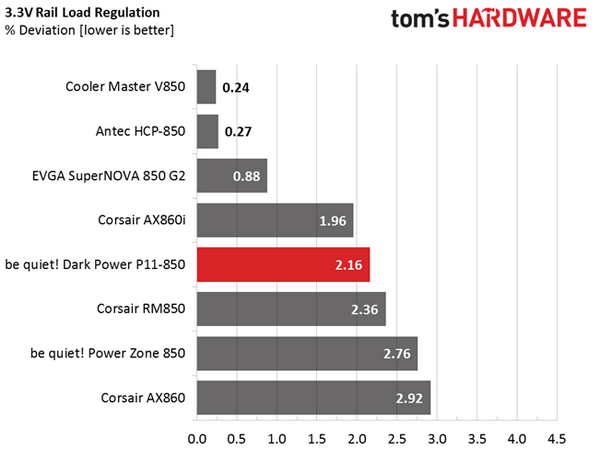
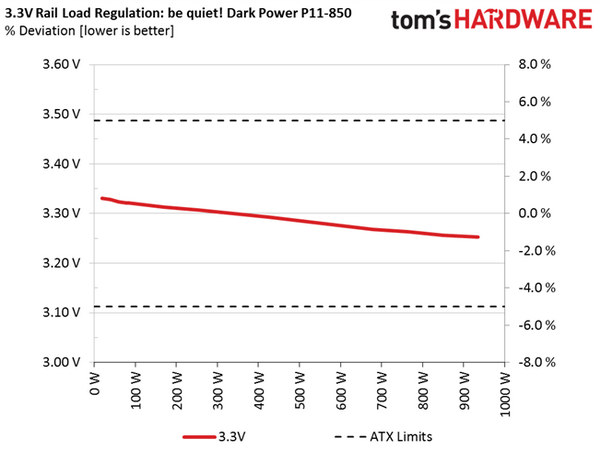
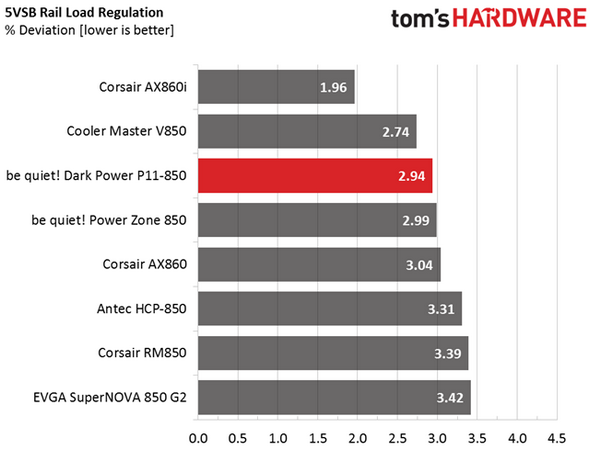

The following charts show the voltage values of the main rails, recorded over a range from 40W to the maximum specified load, and the deviation (in percentage) for the same load range. You will also find a chart showing how the 5VSB rail deals with the load we throw at it.
Hold-Up Time
Our hold-up time tests are described in detail here.

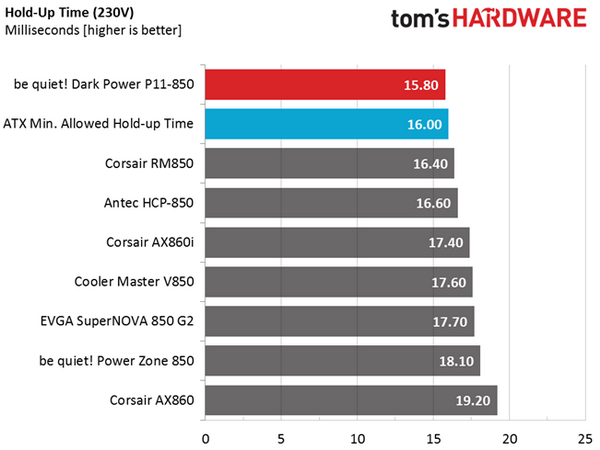
The hold-up time was only 0.2ms away from our desired measurement. We are going to give it a pass, since we always use the least-attractive hold-up test reading (and we repeat them many times) as a worst-case scenario.
Inrush Current
For details on our inrush current testing, please click here.
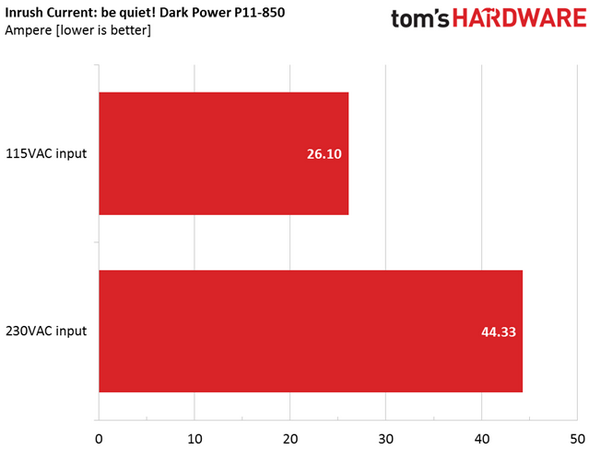
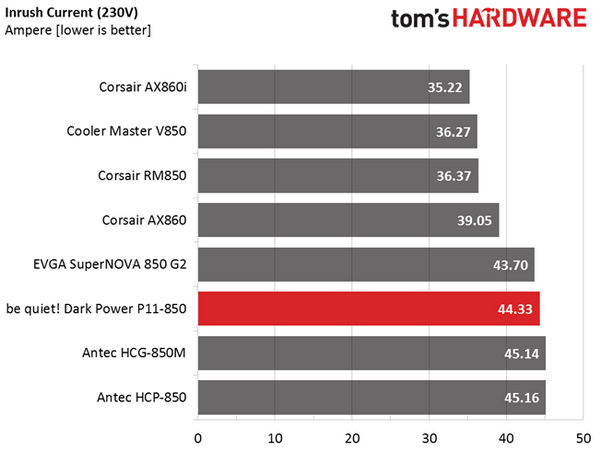
The registered inrush current was low with 115V input and at normal levels with 230V.
Get Tom's Hardware's best news and in-depth reviews, straight to your inbox.
Load Regulation And Efficiency Measurements
The first set of tests reveals the stability of the voltage rails and the PSU's efficiency. The applied load equals (approximately) 10 percent to 110 percent of the maximum load the supply can handle, in increments of 10 percentage points.
We conducted two additional tests. During the first, we stressed the two minor rails (5V and 3.3V) with a high load while the load at +12V was only 0.10A. This test reveals whether a PSU is Haswell-ready. In the second test, we determined the maximum load the +12V rail could handle while the load on the minor rails was minimal.
| Test | 12V | 5V | 3.3V | 5VSB | PowerDC/AC(W) | Efficiency(%) | FanSpeed(RPM) | FanNoisedB(A) | TempIn/Out(°C) | PF/AC(V) |
|---|---|---|---|---|---|---|---|---|---|---|
| 1 | 5.218A | 1.973A | 1.984A | 0.980A | 84.78 | 85.08 | 470 | 19.7 | 38.57 | 0.976 |
| 12.110V | 5.073V | 3.321V | 5.095V | 99.65 | 40.75 | 115 | ||||
| 2 | 11.466A | 2.957A | 2.985A | 1.179A | 169.62 | 89.62 | 560 | 21.3 | 39.29 | 0.994 |
| 12.102V | 5.065V | 3.313V | 5.084V | 189.27 | 42.08 | 115 | ||||
| 3 | 18.089A | 3.457A | 3.504A | 1.377A | 254.81 | 90.98 | 710 | 25.2 | 39.53 | 0.995 |
| 12.093V | 5.059V | 3.307V | 5.071V | 280.06 | 42.55 | 115 | ||||
| 4 | 24.699A | 3.95A | 3.998A | 1.579A | 339.66 | 91.63 | 820 | 30.1 | 39.84 | 0.997 |
| 12.086V | 5.053V | 3.300V | 5.062V | 370.70 | 43.07 | 115 | ||||
| 5 | 30.975A | 4.956A | 5.009A | 1.780A | 424.60 | 91.72 | 1010 | 39.2 | 40.58 | 0.997 |
| 12.078V | 5.045V | 3.293V | 5.049V | 462.92 | 44.03 | 115 | ||||
| 6 | 37.270A | 5.952A | 6.026A | 1.983A | 509.60 | 91.55 | 1235 | 40.3 | 41.65 | 0.998 |
| 12.070V | 5.035V | 3.285V | 5.037V | 556.64 | 45.57 | 115 | ||||
| 7 | 43.570A | 6.965A | 7.049A | 2.186A | 594.59 | 91.23 | 1420 | 42.4 | 42.24 | 0.998 |
| 12.061V | 5.027V | 3.276V | 5.025V | 651.78 | 46.44 | 114.9 | ||||
| 8 | 49.871A | 7.969A | 8.073A | 2.392A | 679.45 | 90.81 | 1480 | 42.7 | 43.03 | 0.998 |
| 12.053V | 5.018V | 3.268V | 5.010V | 748.20 | 47.71 | 114.9 | ||||
| 9 | 56.614A | 8.478A | 8.612A | 2.395A | 764.55 | 90.37 | 1480 | 42.7 | 43.98 | 0.998 |
| 12.046V | 5.012V | 3.263V | 5.005V | 846.05 | 49.27 | 114.9 | ||||
| 10 | 63.107A | 8.995A | 9.121A | 3.010A | 849.38 | 89.76 | 1480 | 42.7 | 44.82 | 0.999 |
| 12.038V | 5.004V | 3.256V | 4.979V | 946.25 | 50.65 | 114.9 | ||||
| 11 | 70.198A | 9.006A | 9.129A | 3.013A | 934.33 | 89.16 | 1480 | 42.7 | 46.22 | 0.999 |
| 12.032V | 4.999V | 3.253V | 4.975V | 1047.90 | 52.39 | 114.9 | ||||
| CL1 | 0.099A | 17.015A | 17.004A | 0.001A | 141.66 | 84.46 | 1480 | 42.7 | 44.11 | 0.993 |
| 12.107V | 4.995V | 3.262V | 5.112V | 167.73 | 48.8 | 115 | ||||
| CL2 | 69.954A | 1.002A | 1.003A | 1.001A | 855.66 | 90.15 | 1480 | 42.7 | 45.35 | 0.999 |
| 12.040V | 5.036V | 3.290V | 5.063V | 949.20 | 51.22 | 114.9 |
Load regulation was top notch at +12V, and on the other three rails it was also pretty good. In addition, the Dark Power PSU was very close to the official 80 PLUS Platinum efficiency requirements, which are rated at much lower operating temperatures than our hotbox's. The noise output up to the 40-percent load test was low, increasing significantly from the 50-percent load test and above. However, even in the worst-case scenario, with the fan spinning at full speed, the noise didn't exceed 43 dB(A). Other PSUs in similar conditions easily surpass 50 dB(A). Finally, the unit easily delivered its full power at high ambient temperatures, proving that its platform is tolerant of extreme heat conditions.
Current page: Load Regulation, Hold-Up Time And Inrush Current
Prev Page A Look Inside And Component Analysis Next Page Efficiency, Temperatures And Noise
Aris Mpitziopoulos is a contributing editor at Tom's Hardware, covering PSUs.
-
Xivilain For lower wattage units, I'd be interested in seeing fanless designs. But it doesn't seem like BeQuiet! is targeting that market, which is sad, because there are lots of HTPC builders out there demanding silence in their living rooms. Anyawy, great review!Reply -
Aris_Mp fanless designs target a very specific market segment mostly because of their increased cost. From the moment you can have inaudible operation at light-mid loads with a proper designed, normal PSU I would highly prefer it especially since it can deliver more power when needed (but with the fan spinning at high enough speeds), than a passive one which will be restricted at 550 - 600 W tops.Reply -
Shankovich ReplyFor lower wattage units, I'd be interested in seeing fanless designs. But it doesn't seem like BeQuiet! is targeting that market, which is sad, because there are lots of HTPC builders out there demanding silence in their living rooms. Anyawy, great review!
I don't see why you cannot have a lower powered unit at 80PG and have the fan run at a low speed. I got a HX750i because I need to give a FirePro W9100 very stable power, but the principle is the same: fan turns on at some higher wattage usage (for me it's 300, but for 80PG I'd say 200 is safer). Even when the fan turns on, can't hear it at all (it has a test button).
If someone makes a 600W PSU that has this kind of fan profile, that would be a score. It won't technically be fanless quite, but the fans won't even get past 15dB for average user power usage, and around 20dB at max settings. Why all this? Will lower the price since a lower efficiency can be used. -
Giannis Karagiannis Since you can have the fan spinning at very low rpm or not at all during light and normal use I can't see a point in having a fanless PSU. During heavy loads, when you need more than 300 watts of power, I believe the noise from the PSU fan would the last thing that would be annoying you.The heat produced be the rest of the system components would be so much that you would need active cooling anywayReply
Another very comprehensive review. Keep up the good work! I would also like to see more reviews for power supplies in the sub-100$ price range. -
dudmont "The prices of the 850, 1000 and 1200W units in the U.S. are $200, $240 and $280, respectively." Yikes!Reply
I'm not convinced that a quieter PSU is where it's at. It's cooling fans that create the big noise, not the PSU and it's fan.
-
Aris_Mp be quiet! informed me that this design/platform was actually designed by one of their engineers and not by FSP, which only helped them build it through their production facilities (since be quiet! doesn't have a PSU manufacturing line).Reply
So in other words be quiet! didn't just bought this platform from FSP but they designed it on their own and FSP just produced it for them.
Until now I wasn't aware of it but now that I am, I wanted to make things right and provide the proper credit to be quiet's engineer that designed this platform (whose name is unknown to me).
